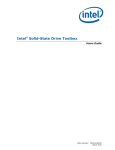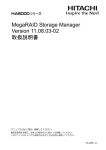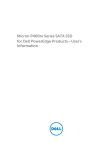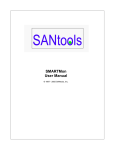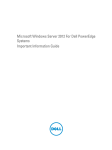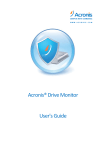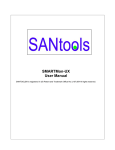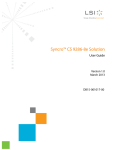Download DELL PowerEdge R320
Transcript
Intel 320 Series SSD User's Information for Dell PowerEdge Products © 2013 Dell Inc. Trademarks used in this text: Dell™, the Dell logo, Dell Boomi™, Dell Precision™ , OptiPlex™, Latitude™, PowerEdge™, PowerVault™, PowerConnect™, OpenManage™, EqualLogic™, Compellent™, KACE™, FlexAddress™, Force10™ and Vostro™ are trademarks of Dell Inc. Intel®, Pentium®, Xeon®, Core® and Celeron® are registered trademarks of Intel Corporation in the U.S. and other countries. AMD® is a registered trademark and AMD Opteron™, AMD Phenom™ and AMD Sempron™ are trademarks of Advanced Micro Devices, Inc. Microsoft®, Windows®, Windows Server®, Internet Explorer®, MS-DOS®, Windows Vista® and Active Directory® are either trademarks or registered trademarks of Microsoft Corporation in the United States and/or other countries. Red Hat® and Red Hat® Enterprise Linux® are registered trademarks of Red Hat, Inc. in the United States and/or other countries. Novell® and SUSE® are registered trademarks of Novell Inc. in the United States and other countries. Oracle® is a registered trademark of Oracle Corporation and/or its affiliates. Citrix®, Xen®, XenServer® and XenMotion® are either registered trademarks or trademarks of Citrix Systems, Inc. in the United States and/or other countries. VMware®, Virtual SMP®, vMotion®, vCenter® and vSphere® are registered trademarks or trademarks of VMware, Inc. in the United States or other countries. IBM® is a registered trademark of International Business Machines Corporation. 2012 - 08 Rev. A00 Contents 1 Intel 320 Series SSD User's Information for Dell PowerEdge Products............................5 About This Document...............................................................................................................................................5 Compatible Hardware...............................................................................................................................................5 12th Generation PowerEdge Servers.................................................................................................................5 11th Generation PowerEdge Servers.................................................................................................................5 SSD Hard Drive Indicator Patterns...........................................................................................................................6 Drive Activity Indicator.......................................................................................................................................6 Drive Status Indicator........................................................................................................................................6 Controller BIOS Configuration Utility Behavior.........................................................................................................7 OMSA Drive Information Page.................................................................................................................................7 SMART Predictive Failure Notification Support.................................................................................................7 SMART Wear Out Indicator Not Supported.......................................................................................................8 OMSA Warnings.......................................................................................................................................................8 System Alerts Page............................................................................................................................................8 Storage Pages....................................................................................................................................................9 Wear Usage Monitoring.........................................................................................................................................10 The Smartmon Tool..........................................................................................................................................10 Obtaining the Smartmon Tool...........................................................................................................................10 SMART Attributes............................................................................................................................................10 Smartmon Tool and smartctl Resources..........................................................................................................11 Monitoring Drive Wear Example Using the Smartmon Tool — Linux RAID Environments..............................11 Monitoring Drive Wear Example Using the Smartmon Tool — Non-RAID Environments...............................11 Using the Smartmon Tool to Estimate Wear Usage — Windows RAID Environments ONLY..........................11 Calculating Estimated Drive Wear...................................................................................................................13 Adjusting SSD Usable Capacity to Improve Drive Performance............................................................................14 Intel 320 SSD ATA Instant Secure Erase Functionality ..........................................................................................14 2 Getting Help................................................................................................................................15 Contacting Dell.......................................................................................................................................................15 4 Intel 320 Series SSD User's Information for Dell PowerEdge Products 1 About This Document This document describes features and behaviors of the Intel 320 Series SSDs that you may encounter when using these drives in a Dell PowerEdge server. Compatible Hardware 12th Generation PowerEdge Servers The following 12th Generation Dell PowerEdge servers are currently qualified as compatible with the Intel 320 Series SDDs: • PowerEdge R820 • PowerEdge R720 • PowerEdge R720xd • PowerEdge R620 • PowerEdge T620 • PowerEdge R520 • PowerEdge R420 • PowerEdge R320 The following controllers are supported by these servers for use with the Intel SSDs: • H710 • H710P • H310 Note that the H810 and S110 controllers are NOT qualified for use with the Intel SSDs. 11th Generation PowerEdge Servers The following 11th Generation Dell PowerEdge servers are currently qualified as compatible with the Intel 320 Series SDDs: • PowerEdge R910 • PowerEdge R815 • PowerEdge R715 • PowerEdge M915 The following controllers are supported by these servers for use with the Intel SSDs: 5 • H700 • H200 Note that the H800, S100, and S300 controllers are NOT qualified for use with the Intel SSDs. NOTE: Additional servers and controllers may be qualified in the future as compatible with Intel 320 Series SDDs. Contact your Dell sales representative for the latest information. SSD Hard Drive Indicator Patterns Figure 1. Hard-Drive Indicators 1. hard-drive activity indicator (green) 2. hard-drive status indicator (green and amber) Drive Activity Indicator NOTE: The drive activity indicator behavior on an SSD is noticeably different than that of a hard disk drive. When SSD I/O activity is occurring, the indicator will switch on and remain on without blinking. This is normal behavior. SSD Drive Activity Indicator Pattern Condition Off No drive activity Steady green Drive I/O activity occurring Drive Status Indicator The hard-drive status indicator functions the same as that of a hard disk drive. SSD Drive Status Indicator Pattern (RAID Only) Condition Blinks green two times per second Identifying drive or preparing for removal Off Drive ready for insertion or removal 6 SSD Drive Status Indicator Pattern (RAID Only) Condition NOTE: The drive status indicator remains off until all hard drives are initialized after the system is turned on. Drives are not ready for insertion or removal during this time. Blinks green and off Predicted drive failure Blinks green slowly Drive rebuilding Steady green Drive online Blinks green three seconds and off six seconds Rebuild aborted Controller BIOS Configuration Utility Behavior The BIOS Configuration Utility is a storage management application embedded on PowerEdge Raid Controller (PERC) cards that configures and maintains RAID disk groups and virtual disks. (For more information on the utility, see the Dell PowerEdge RAID Controller User’s Guide.) The utility's Physical Disk Management screen displays physical disk information and action menus. On the right side of the screen, the SSD's Certified field will be set to “No.” This is normal behavior and does not indicate an issue with the drive. Figure 2. Controller BIOS configuration utility OMSA Drive Information Page SMART Predictive Failure Notification Support SMART trips for actual drive errors will be noted on the Physical Disks page of the OpenManage Server Administrator (OMSA) Storage subsection. If such an error occurs, “Yes” will be displayed in the Failure Predicted column of this page. 7 Figure 3. Drive information page with predictive failure notice SMART Wear Out Indicator Not Supported Although the Intel SSD 320 Series drives log SMART attribute E9, Media Wear Out Indicator, that captures the remaining life of the SSD as a percentage, the OMSA Physical Disks page does not report this indicator. OMSA Warnings NOTE: Dell OpenManage Server Administrator (OMSA) will displays a yellow warning icon next to the Intel SSDs, as noted below. These warning icons do not indicate a current or pending problem with the drive. They only appear because the drive is not recognized by OMSA as a “Dell-branded” drive. System Alerts Page A yellow warning icon and a“Non-Dell-supplied disk drive has been detected.” message will be displayed next to each Intel SSD drive. This is normal behavior and does not indicate an issue with the drive. 8 Figure 4. OMSA system alerts page Storage Pages Within the Storage section of OMSA, a yellow warning icon will appear on the controller page, and the Physical Disks page. This is normal behavior and does not indicate an issue with the drive. Figure 5. Controller page 9 Figure 6. Physical disks page Wear Usage Monitoring The Smartmon Tool You can use a software tool — Smartmon — that monitors three Self-Monitoring, Analysis, and Reporting Technology (SMART) attributes for SSDs. Smartmon includes a command line utility, smartctl, used to check these attributes. Obtaining the Smartmon Tool The Smartmon tool is available from the following sources: • From Intel as part of the “Intel Solid-State Drive Toolbox” at http://downloadcenter.intel.com. • From http://sourceforge.net/apps/trac/smartmontools/wiki. NOTE: Use the latest version of the Smartmon tool with the Intel 320 Series SSDs. SMART Attributes The three primary attributes measured by the Smartmon tool are: 10 • Workload Timer ID E4h — Time elapsed during the current workload. • Timed Workload Host Reads Percentage ID E3h — Percentage of I/O operations that are read operations during the last workload timer loop. • Timed Workload Media Wear Indicator ID E2h — Drive wear during the last wear timer loop, as a percentage of the maximum rated cycles. NOTE: You must run the workload to be evaluated for at least 60 minutes for these SMART drive attributes to register. Smartmon Tool and smartctl Resources For details of the Smartmon tool, the smartctl utility, and SMART attributes, refer to: • “Intel Solid-State Drive 320 Series in Server Storage Applications” and “Intel Solid-State Drive 320 Series Enterprise Server/Storage Application Product Specification Addendum,” available at http:// downloadcenter.intel.com. • smartctl man page, available at http://smartmontools.sourceforge.net/man/smartctl.8.html. Monitoring Drive Wear Example Using the Smartmon Tool — Linux RAID Environments Note that the specific options in this example may not apply to your system. For details of the smartctl commands and options, see the resources in “Smartmon Tool and smartctl Resources.” 1. Find the OS name for the storage device or RAID array. 2. Find device ID’s for the device or array in step 1 using MegaCli using the following command: MegaCli64 –pdlist –aAll 3. For each device ID use the following command: smartctl -a -d sat+megaraid,N /dev/sdX N represents the device ID identified in step 2. – X represents the storage device or RAID array identified in step 1. 4. In the smartctl output, Attribute ID# 233, Media Wearout Indicator, will indicate the remaining drive life as a percentage under the VALUE column. For example, a value of 85 means 85% of the drive's life remains. – Monitoring Drive Wear Example Using the Smartmon Tool — Non-RAID Environments Note that the specific options in this example may not apply to your system. For details of the smartctl commands and options, see the resources in “Smartmon Tool and smartctl Resources.” 1. Find the OS name for the storage device. 2. For each device ID use the following command: smartctl -a -d sat/dev/sdX. X represents the storage device or RAID array identified in step 1. 3. In the smartctl output, Attribute ID# 233, Media Wearout Indicator, will indicate the remaining drive life as a percentage under the VALUE column. For example, a value of 85 means 85% of the drive's life remains. – Using the Smartmon Tool to Estimate Wear Usage — Windows RAID Environments ONLY NOTE: In a Windows RAID environment, an individual SSD device cannot be directly accessed behind the LUN (Logical Unit or RAID configured set) so it must be temporarily moved to a NON-Windows (Linux) SMART-capable system during portions of the procedure as noted below, in order to issue SMART commands to the drive. You can use the following procedure to estimate wear in a Windows RAID production or application environment. This procedure applies to Linux and Windows operating systems, and RAID or non-RAID environments. 11 The high-level steps of the procedure are as follows: • • • • Obtain a baseline wear indicator Run the intended application for an extended time period Re-check the wear indicator Calculate wear over time 1. Make sure DIPM is disabled to ensure that the data collected is accurate. 2. Temporarily move the drive to a NON-Windows (Linux) SMART-capable system. 3. Issue the SMART EXECUTE OFF-LINE IMMEDIATE (D4h) sub-command 40h to reset the E4h (workload timer) attribute. – For example, utilizing smartctl version 5.43 in a Linux OS where the drive under test is /dev/sda you can enter the following command line: smartctl –t vendor,0x40 /dev/sda. Figure 7. Resetting the SMART workload timer attribute 4. Return the drive to the Windows system where the workload will be measured. 5. Run the workload to be evaluated for at least 60 minutes (otherwise the drive wear attributes will not be available). – – For this example, the workload was run for about 22 hours. Iometer was used with a transfer size of 1MB with 100% random writes. 6. Do a clean system power down. Use either the ATA STANDBY IMMEDIATE command or leave the drive in the system for 10 minutes prior to shutting down the system. This ensures that the drive will store all the drive wear SMART attributes to persistent memory within the drive. 7. Return the drive to a non-Windows (Linux) SMART-capable system (the same system environment of step 2). 8. Read the drive wear attributes with the SMART READ DATA (D0h) command within 60 minutes after power-up. – For example, a drive in a system with smartctl version 5.43 captures the SMART Read Data by running the following command line: smartctl –A /dev/sda. 12 – Note that the attribute ID# are listed in decimal and not in Hex with the Attribute_NAME associated with Hard Drives. Figure 8. Reading the SMART drive wear attributes The table below translates the data from smartctl to the Intel-supported SMART Attributes. Table 1. Converting SMART attribute values Attribute Decimal ID Hex ID Raw Value Host Writes Count 225 E1h 477242 Timed Workload Media Wear Indicator 226 E2h 635 Timed Workload Host Read/ 227 Write Ratio E3h 0 Workload Timer E4h 1367 228 Calculating Estimated Drive Wear From the data collected using smartctl, and the translated values, you can then calculate the drive wear rate based on the given workload. Using this example: • Timed Workload Media Wear (E2h) has a raw value of 635. Therefore, the percentage wear rate = 635/1024 = 0.620% • Timed Workload Host Read/Write Ratio (E3h) has a normalized value of 0, indicating that 0% of the operations were reads. This corresponds with the 100% random write workload set in Iometer. • Workload Timer (E4h) has a raw value of 1367. Therefore the workload ran for 1367 minutes or 22.783 hours. Given these values, the media wear percentage rate for this workload can then be calculated: 13 • Timed Workload Media Wear rate of 0.620% for every 1367 minutes: – Workload Media Wear Rate 0.027% per hour – Workload Media Wear Rate 0.653% per day Using the drive in this 100% workload example, the drive wears at .653% per day. • 100/.653 = 153 • In this exaggerated case, the drive will use 100% of wear in 153 days NOTE: This sample usage case is an exaggerated workload of 100% writes. The wear rate and related values for this device's intended use in read-intensive environments will be notably different, with the wear rates markedly lower. The above workload was used in this case to demonstrate the procedure and calculations. Adjusting SSD Usable Capacity to Improve Drive Performance Some SSD performance gains can be realized in random write performance and endurance by configuring a small reduction in the drive's usable capacity. Intel provides details on this option in Intel Solid-State Drive 320 Series in Server Storage Applications at http://www.intel.com. NOTE: If you wish to implement this feature, you must do so before the drive is initialized or written to in any way. After the drive contents are altered, secure erasure of the drive to change its usable capacity is not supported. Intel 320 SSD ATA Instant Secure Erase Functionality Intel 320 SSDs support cryptography-based Instant ATA secure erase functionality. The Intel 320 SSD Instant ATA secure ease feature is non-TCG (Trusted Computing Group) based. It supports two modes of crypto secure erase: • Normal secure erase—Clears the encryption keys and erases NAND • Enhanced secure erase—Generates new keys and clears NAND. The PERC solution only supports the “crypto erase” function on TCG-compliant Enterprise SED (Self Encrypting Drive) drives. When an Intel 320 drive is connected to a PERC, there is an incompatibility between PERC TCG method of crypto erase and Intel 320 supported non-TCG based ATA instant secure erase. As a result, the instant secure erase functionality can’t be used with PERC based solution. The only way to run instant ATA secure ease and use Intel 320 drive secure wiping feature is to connect the drives directly into the motherboard chipset’s ATA port and issue secure erase command. Intel provides a free utility (Intel SSD Toolbox) to instant secure erase the drive, which you can download from www.intel.com/go/ssdtoolbox. 14 Getting Help 2 Contacting Dell NOTE: If you do not have an active Internet connection, you can find contact information on your purchase invoice, packing slip, bill, or Dell product catalog. Dell provides several online and telephone-based support and service options. Availability varies by country and product, and some services may not be available in your area. To contact Dell for sales, technical support, or customer service issues: 1. Visit dell.com/support 2. Select your support category. 3. Verify your country or region in the Choose a Country/Region drop-down menu at the top of page. 4. Select the appropriate service or support link based on your need. 15
















